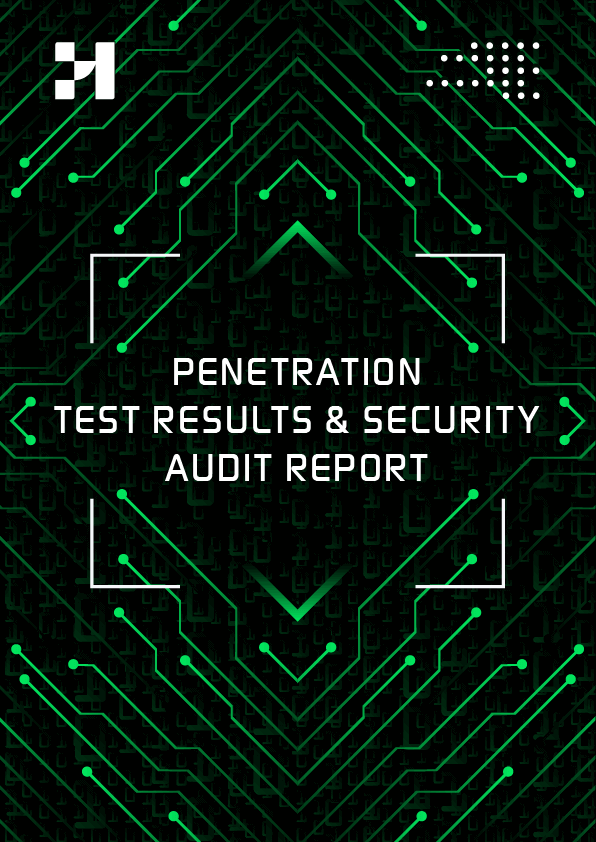Next Generation Penetration Testing
Proactively identify vulnerabilities in your system and take precautions before hackers launch a digital attack with penetration tests that deliver simulated, real-time results in a secure and controlled environment.
Strengthen Your System Security with UlgenAI-Supported Penetration Testing!
Penetration testing is a risk-free method that verifies a system’s security by simulating real-time cyber attacks. Its aim is to detect and eliminate security vulnerabilities to reduce future attack risks. Hackdra combines the power of ethical hackers and expert security engineers with the advanced artificial intelligence technology UlgenAI to provide high-level security, identifying the source of attacks and offering uninterrupted security services.
Full-Scale Security Risk Reporting
Detect Multiple Vector Security Vulnerabilities
Actionable Findings for Developers
No Business Interruption
High Degree of Accuracy
Penetration Testing is a Critical Task in Ensuring and Improving Security
Cyber attacks and data breaches pose a serious threat to businesses today. Penetration testing helps organizations enhance their data security by identifying security vulnerabilities. With Hackdra’s AI-supported solutions and ethical hacker support, reducing data breach costs and strengthening security is now possible. Explore our penetration testing solutions to fortify your business’s security and reduce data breach costs.
Ensure Your Security with Customized Penetration Testing Types!
Each type of test aims to identify and address security vulnerabilities in a specific area. These tests help organizations enhance data security by reducing information security risks. Regular security testing ensures that organizations are prepared for cyber attacks and enhances data security. Therefore, regular penetration testing is important for securing organizations’ information systems.
Web Service & API
Blockchain
Web Application
Infrastructure & Cloud
Mobile Application
External Network
Internal Network
Source Code
Desktop Application
Email Server
Industrial Control Systems
IoT Devices
Operating System
Pentest Methods with Special Scenarios
Every system and application is unique, and standard tests may not always be sufficient. In addition to traditional methods, customized penetration testing solutions with special scenarios focus precisely on your needs and challenges. This approach provides specially designed solutions to maximize your company’s security.
Methods
Which industries need penetration testing?
Data security is an indispensable requirement for every organization in today’s digital world. Regular penetration tests help identify weak points before attackers can exploit them, keeping your system secure. Furthermore, legal regulations and customer expectations mandate the continuous improvement of security standards. So organizations not only save costs but also effectively protect their customers’ data.
Finance and Banking
Healthcare
Centralized and Decentralized Exchanges (CEX & DEX)
Cryptocurrency Mining and Wallets
Play-to-Earn and Game-Based Finance
Government and Public Services
E-commerce and Retail
Energy and Utility Companies
Telecommunications and ISPs
Insurance
Benefits of working with Hackdra
Identifying and addressing vulnerabilities in your system and applications is essential. Our team of experts increases your company’s security by identifying potential and hidden risks with customized solutions for your needs. We also provide timely alerts, recommendations, and ongoing support to ensure your operations remain secure. In this way, you can reduce possible risks and protect your company’s reputation.
Enhanced Security
Trust and Reputation
Regulatory Compliance
Expertise and Experience
Timely and Efficient Process
Transparent Pricing
Ongoing Support
Customized Solutions
Penetration Testing Process
To ensure the highest level of information security, we harness the power of our ethical hackers and cybersecurity experts, combining it with the dynamism of UlgenAI to develop comprehensive custom scenarios. We test our clients’ systems with the latest technologies, identify and address security vulnerabilities, and maintain transparent communication throughout the process. By providing real-time reports, we assist our clients in keeping their security at the highest level. We invite you to join us in securing your business!
Initial Engagement
Planning
Data Collection
Attack Simulation
Test Application and Real-time Finding Sharing
Patching
Reporting
Monitoring
Closure
Compliance-driven Penetration Testing
Conduct Your Business with Confidence, Attain Compliance at the Highest Standards
Pentest offers a comprehensive testing service that covers all the essential requirements for achieving compliance with major compliance standards such as ISO 27001, HIPAA, SOC2, GDPR, PCI DSS, FISMA, NIST, COBIT and KVKK, as well as various other compliance frameworks. By ensuring the highest standards of information security and privacy, companies can operate with confidence.
What does a Penetration Testing report include?

General condition and configuration of the tested system or network,
Detailed classification of identified security vulnerabilities according to their importance levels,
Potential impacts and risk levels of each vulnerability,
Step-by-step recommendations for addressing security vulnerabilities,
Details of the patch to be applied,
Suggestions for performance improvement,
Scoring of architectural quality, code quality, and security elements.
FAQ
Ask Us a Question
If you have any questions about Penetration Testing, please first check the FAQ section. If you still can’t find an answer, feel free to contact us or ask your question quickly. We are happy to assist you.
The cost of a pen test depends on the scope and complexity of the systems being tested. Our clients receive a detailed breakdown of costs for transparent penetration test pricing before starting the pentest. There are no hidden fees. The average cost of a penetration test depends on its type and the complexity of the system. A properly conducted penetration test is much more cost-effective than the potential cyber threat costs you might encounter. After requesting a quote, we will provide you with a detailed pricing breakdown for your project. You will have a team of experts and ethical hackers working to identify every possible way your systems could be at risk. If you don’t know where to start or which systems to test first, our security experts will make recommendations, highlight potential weak points, guide you at every step, and assist you in making the pen test cost-effective for you overall.
A penetration test involves the simulation of real-world attack techniques by ethical hackers in a secure environment. This test helps identify potential weak points and enables proactive measures against potential threats. It is crucial for maintaining the security of your system, ensuring the safety of customer and user data, preventing reputational and financial losses, and ensuring compliance with legal regulations.
Penetration tests are conducted in a secure and controlled environment by ethical hackers and expert teams. Such security tests do not cause harm to the systems being tested.
Black Box Penetration Testing simulates a scenario in which the attacker has no prior knowledge. This creates a scenario where the attacker attempts to gain external access to the system to assess the effectiveness of the system’s defense.
In Gray Box testing, a scenario is simulated in which the attacker has limited internal knowledge. This type of test provides limited access to the internal structure and some details of the system being tested.
White Box testing, on the other hand, provides full access to all details and the internal structure of the system being tested. This type of test involves a detailed examination and analysis of all vulnerabilities and security flaws in the system.
The complexity of the project or system, security requirements, budget, and time constraints are important factors in determining the appropriate type of penetration test. More complex, critical, and sensitive systems may generally be more suitable for white box testing, while simpler systems may suffice with black box testing. More comprehensive and detailed tests often require more time and resources, while black box testing may be preferred for faster results.
These types of tests are used to assess the security level of the system by simulating different scenarios based on the attacker’s level of knowledge. Taking these factors into account, we provide our clients with a detailed requirements report during the initial consultation to help determine the most suitable type of penetration test.
The penetration testing process includes the following steps:
- Target Definition: First, the scope and objectives of the test are determined. It is planned which systems, networks, or applications will be tested and which types of attack scenarios will be simulated.
- Authorization: Necessary permissions and authorizations for penetration testing are obtained. This step ensures that the test is conducted in compliance with legal and regulatory requirements.
- Information Gathering: Prior to the test, as much information as possible about the target systems and networks is collected. This enables the test to be conducted more effectively and efficiently.
- Creation of Attack Scenarios: Different attack scenarios are created for the test. These scenarios aim to identify the security vulnerabilities of the system by simulating real-world attack techniques.
- Implementation of Penetration Testing: Penetration testing is carried out in accordance with the created attack scenarios. Ethical hackers or security experts identify security vulnerabilities by launching attacks on the system.
- Reporting: The test results are reported in detail. The identified security vulnerabilities and recommended solutions are reported, outlining the steps to be taken to enhance the system’s security.
This process is important for assessing the security level of the system and identifying security vulnerabilities.
- System and Network Information: Details of the systems and networks to be tested, technical details such as IP addresses, server information, etc., should be shared.
- Expectations and Objectives: You should clearly express your expectations and the objectives you aim to achieve during the penetration testing process.
- Legal and Regulatory Information: If your project has legal and regulatory requirements, there may be information that needs to be shared in this regard.
Sharing this information is important for the efficient and effective execution of the penetration testing process. During the initial consultation with our expert team member, you will receive guidance on securely sharing your information.
The following types of attack scenarios are typically examined within the scope of penetration testing:
Network Attacks: Attack scenarios conducted over the network are examined. This may include unauthorized access to network traffic, compromising network devices, and similar situations.
Web Application Attacks: Attack scenarios targeting web-based applications are examined. This may include attack types such as SQL injection, cross-site scripting (XSS), and cross-site request forgery (CSRF).
Physical Security Attacks: Attack scenarios that could be carried out through physical access are examined. This may include attempts to damage computer systems or network infrastructure through physical access.
Social Engineering Attacks: Attack scenarios aimed at manipulating users to obtain sensitive information are examined. This may include tactics such as phishing emails and phone scams.
Examining these scenarios allows for the identification of security vulnerabilities in the tested systems from different perspectives. This enables the overall security level of the system to be assessed and necessary measures to be taken.
- Remediation of Security Vulnerabilities: Updates can be made to relevant systems to address identified security vulnerabilities and flaws, software errors can be corrected, and configuration settings can be reviewed.
- Reinforcement of Firewalls: Based on the results of penetration testing, network security firewalls and other security measures can be strengthened, and if necessary, new security measures can be added to enhance the defense mechanisms of the network.
- Staff Training: Training programs can be organized to increase employee security awareness based on the results of penetration testing, and security policies can be reviewed.
- Updating Emergency Plans: Based on the results of penetration testing, emergency plans for potential security breaches can be updated, and crisis management processes can be reviewed.
- System Monitoring and Logging: Based on the results of penetration testing, system monitoring and logging processes can be strengthened, and a more effective infrastructure for the detection and intervention of security events can be established.
These measures can be taken based on the results of penetration testing to enhance the security level of the system and minimize potential security risks.
Penetration testing is performed by Hackdra ethical hackers and expert security team. These experts, who have nothing to do with issues other than fighting cybercrime, are professionals with information security certificates. Hackdra uses special software and methods developed by itself to achieve the most effective results. In this way, it guarantees that the test gives successful and reliable results.
The results obtained after the penetration test are reviewed and evaluated. The identified security vulnerabilities and weaknesses are reported and shared with the system owner. Subsequently, the necessary steps to address these vulnerabilities are discussed with the client. Depending on the client’s request, security measures in the system are strengthened, software errors are corrected, and configuration settings are reviewed. Additionally, training programs can be organized to increase employees’ security awareness, and security policies can be reviewed. Based on the results of the penetration test, emergency plans are updated, and crisis management processes are reviewed. System monitoring and logging processes are strengthened, and a more effective infrastructure for detecting and responding to security incidents can be established. These practices, carried out at the client’s request after the penetration test, aim to enhance the system’s security level and minimize potential security risks. These activities following the penetration test are not part of the test itself and involve strengthening the system based on the test results.












